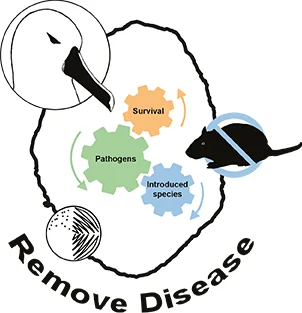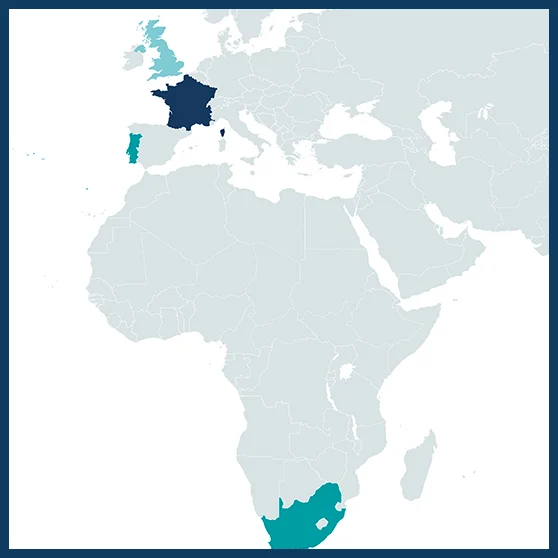
01.04.2022 – 31.03.2025
€ 400,428
Thierry BOULINIER
thierry.boulinier@cefe.cnrs.fr
Coordinator: Center for Evolutionary and Functional Ecology (CEFE), CNRS/Montpellier University/IRD/SupAgro/EPHE, Montpellier, France
National Nature Reserve of the French Southern Lands, Saint Pierre, La Réunion, France
Marine and Environmental Sciences (MARE), ISPA – University Institute, Lisboa, Portugal
Bird Life International, Cambridge, United Kingdom
Falklands Conservation, Stanley, United Kingdom
Seabird Conservation Programme, Bird Life South Africa, Johannesburg, South Africa
Institute for Coastal and Marine Research, Nelson Madela University, Port Elizabeth, South Africa
FitzPatrick Institute of African Ornithology, University of Cape Town, Rondebosch, South Africa

Invasive species are one of the main threats to biodiversity, and species most susceptible to invade inhabit marine islands which were home to >90% of the bird species that have gone extinct over the last 500 years. Island ecosystems are unique and particularly vulnerable to invasive species, disease spread and other threats. Relatively recently, a momentum has been building worldwide to control the spread of introduced species, develop protocols to decrease the risk of introducing new species, and, when possible, eradicate invasive alien species. In the Southern Ocean, the impact of these threats on Antarctic and sub-Antarctic terrestrial ecosystems is particularly exacerbated by environmental change. Ambitious restoration projects based on the eradication of introduced mammal species from islands (such as rats, mice and cats) are being implemented, but they very rarely consider the potential role of pathogens as a threat to native seabirds, despite their potential importance. In this context, project REMOVE_DISEASE aims at exploring the impact of the eradication of introduced species on the dynamics of pathogens and biodiversity on islands.
In densely breeding species, such as seabirds, the threat posed by pathogens is increasingly recognised, and in some cases introduced mammal species are suspected to be playing key roles as maintenance reservoirs or vectors of transmission, such as on Amsterdam Island, in the south of the Indian Ocean, where yearly epizooties of avian cholera kill thousands of nestlings. Records of infectious diseases of seabirds have been reported on other islands, where they could contribute to threaten host species. In this project, we aim at exploring the effects of the eradication of introduced mammal species on the dynamics of exposure of native seabird species to infectious agents on islands. Moreover, we will explore the mechanisms by which those changes may occur and their potential long-term implications. By including avian scavengers as sentinel species in epidemiological surveys pre- and post-eradication, we will maximise our ability to detect effects. In parallel, we will investigate how consideration of these epidemiological aspects could benefit the implementation of large-scale biodiversity restoration projects. REMOVE_DISEASE will benefit from interdisciplinary approaches, independently funded restoration efforts, and from being conducted on islands that have been the subject of detailed monitoring and conservation biology studies by the international partner teams.
The test of the eco-epidemiological impact of introduced mammal eradication plans on eco-epidemiological dynamics will directly benefit from being conducted in anticipation and in parallel with the management plans to restore the ecosystems. The outcomes of REMOVE_ DISEASE will further have relevance for inverse zoonoses, i.e. the transmission of infectious diseases from humans to wild animals, which has specifically been identified as an important risk in southern polar areas in the case of enterobacteria and coronaviruses. The four self-funded partners and stakeholders, the National Nature Reserve of the French Southern Lands, Bird Life International, Falklands Conservation and Bird Life South Africa, will be engaged via their involvement in the project meetings, the coordinated planning of fieldwork, and the interpretation and dissemination of the results. Each eradication project costs much, so the explicit consideration of the possible extra benefit of eradicating infectious disease may be of critical importance. The communication plan will benefit from the strong experience of several of the partners, notably BirdLife Internatiobal , but also the academic teams. The study will be conducted in polar contexts, with relatively simple systems (few species), but the results will be of importance for eradication of introduced mammals on islands worldwide, including in temperate and tropical ecosystems.
The findings could highlight how the eradication of introduced species from islands can directly benefit the conservation of biodiversity by relieving native species from predation pressure from those species, but also indirectly via its effect on disease agents. This is especially important in the current context of global change, with potential increased risks of infectious disease spread and emergence. Stakeholders involved as partners are a government environmental agency (the National Nature Reserve of the French Southern Lands) and non-governmental organisations (BirdLife South Africa, Falklands Conservation, and BirdLife International) that are critically involved in biodiversity conservation. The direct involvement of stakeholders in an international setting will contribute to achieving the objectives of the project and its broad implications.
The project will focus on three groups of islands of the Southern Ocean which host large native seabird populations of albatrosses, penguins and burrowing petrels, suffering from introduced mammal species. Case studies benefiting from detailed long-term monitoring of bird populations will be conducted on Amsterdam Island (French Southern and Antarctic Lands), Marion Island (South Africa) and New Island (Falkland/Malvinas Islands). The implementation of restoration efforts via introduced species eradication plans such as on Amsterdam and Marion islands will enable a quasi-experimental approach of the effect of introduced species on eco-epidemiological dynamics.
- Agence Nationale de la Recherche (ANR), France
- Fundação para a Ciência e a Tecnologia (FCT), Portugal
- Water Research Commission (WRC), South Africa